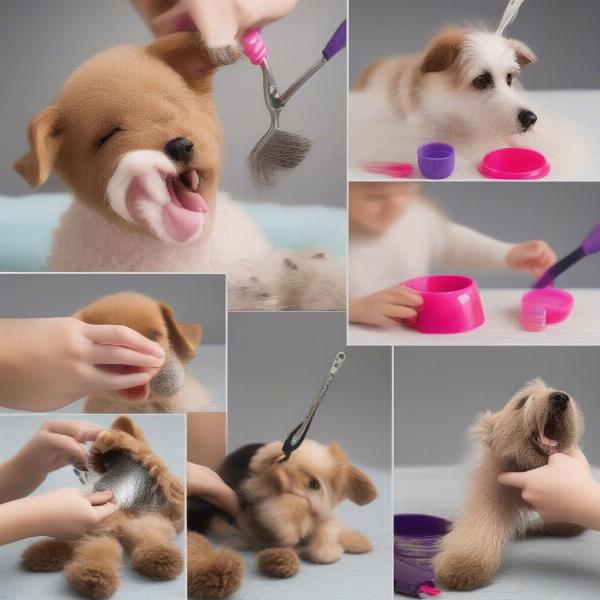Toy pet dogs, with their diminutive size and charming personalities, have captured the hearts of many. These pocket-sized pups are ideal companions for apartment dwellers, busy professionals, and those seeking a low-shedding pet. But owning a toy breed isn’t just about cuddles and cuteness. This comprehensive guide will delve into everything you need to know about selecting, caring for, and nurturing your perfect toy pet dog.
Choosing the Right Toy Breed for You
Selecting a toy breed is a significant decision. Each breed boasts unique characteristics, temperaments, and care requirements. Are you looking for a playful and energetic companion like a Chihuahua or a more laid-back lap dog like a Cavalier King Charles Spaniel? Consider your lifestyle, living situation, and experience with dogs.
Factors to Consider When Choosing a Toy Breed
- Temperament: Research the typical temperament of each breed. Some breeds are known to be more independent, while others are more affectionate and clingy.
- Activity Level: Some toy breeds are surprisingly energetic and require regular exercise, while others are content with short walks and indoor play.
- Grooming Needs: Long-haired toy breeds require more frequent brushing and grooming than short-haired breeds.
- Health Concerns: Certain toy breeds are predisposed to specific health issues. Understanding these potential problems is crucial for responsible ownership.
- Training: Some toy breeds are known to be more challenging to train than others.
Essential Care for Your Toy Pet Dog
Regardless of the specific breed, all toy pet dogs require specialized care due to their small size and delicate nature.
Nutrition and Feeding
Toy breeds have faster metabolisms than larger dogs and require more frequent meals. Choose a high-quality dog food formulated specifically for small breeds to ensure they receive the necessary nutrients.
Exercise and Activities
Even small dogs need regular exercise to maintain their physical and mental health. Short walks, playtime in a secure area, and interactive toys can provide the necessary stimulation.
Grooming
Regular grooming is essential for keeping your toy pet dog looking and feeling their best. This includes brushing, bathing, nail trimming, and dental care.
 Caring for your toy pet dog
Caring for your toy pet dog
Health Concerns in Toy Breeds
Toy breeds are prone to certain health issues due to their size and genetics. Regular veterinary checkups and preventative care are crucial. Some common health concerns include:
- Hypoglycemia: Low blood sugar, which can be life-threatening if not treated promptly.
- Patellar Luxation: A condition where the kneecap slips out of place.
- Tracheal Collapse: A weakening of the trachea, which can cause breathing difficulties.
- Dental Issues: Toy breeds are prone to dental disease, so regular teeth cleaning is essential.
Training and Socialization
Early training and socialization are vital for toy breeds. They can be prone to developing “small dog syndrome” if not properly trained and socialized. dog boarding brantford can be a good option for socialization and training if you are busy.
Housebreaking Your Toy Pet Dog
Housebreaking a toy breed can be challenging due to their small bladder size. Consistency, patience, and positive reinforcement are key.
Living with a Toy Pet Dog: Tips and Tricks
- Safety First: Protect your tiny companion from potential hazards in your home.
- Socialization is Key: Expose your toy dog to a variety of people, dogs, and environments.
- Consistency in Training: Establish clear rules and boundaries.
- Enrichment and Stimulation: Provide plenty of toys and activities to keep your toy dog entertained.
Conclusion
Owning a toy pet dog can be a rewarding experience. These charming companions offer unconditional love and companionship. By understanding their specific needs and providing proper care, you can ensure a long, happy, and healthy life for your tiny friend. Remember to research different breeds, consider your lifestyle, and commit to providing the necessary care and attention. cape may dog friendly rentals could be a great option if you’re planning a vacation with your toy pet dog.
FAQ
- What is the smallest toy dog breed? The Chihuahua is generally considered the smallest breed.
- Are toy dogs good for apartments? Yes, their small size makes them well-suited for apartment living.
- Do toy dogs bark a lot? Some toy breeds are prone to barking, while others are relatively quiet.
- How much exercise do toy dogs need? They need regular exercise, but the amount varies depending on the breed.
- Are toy dogs good with children? Some toy breeds are better with children than others. Supervision is always essential.
- How long do toy dogs live? They generally have a longer lifespan than larger breeds, often living for 12-16 years.
- Are toy dogs expensive to maintain? The cost of care can vary depending on factors such as food, grooming, and veterinary care.
ILM Dog is your trusted resource for all things dog-related. We offer expert advice on dog breeds, health, training, nutrition, and more. Whether you’re a seasoned dog owner or just starting out, ILM Dog has the information you need to provide the best possible care for your canine companion. Contact us today for expert advice and support at [email protected] or +44 20-3965-8624. Visit our website at ILM Dog for more valuable information on dog care, including articles on specific toy breeds like the bee dog toy or the durable dog fire hose toy. We’re passionate about helping you and your furry friend thrive.